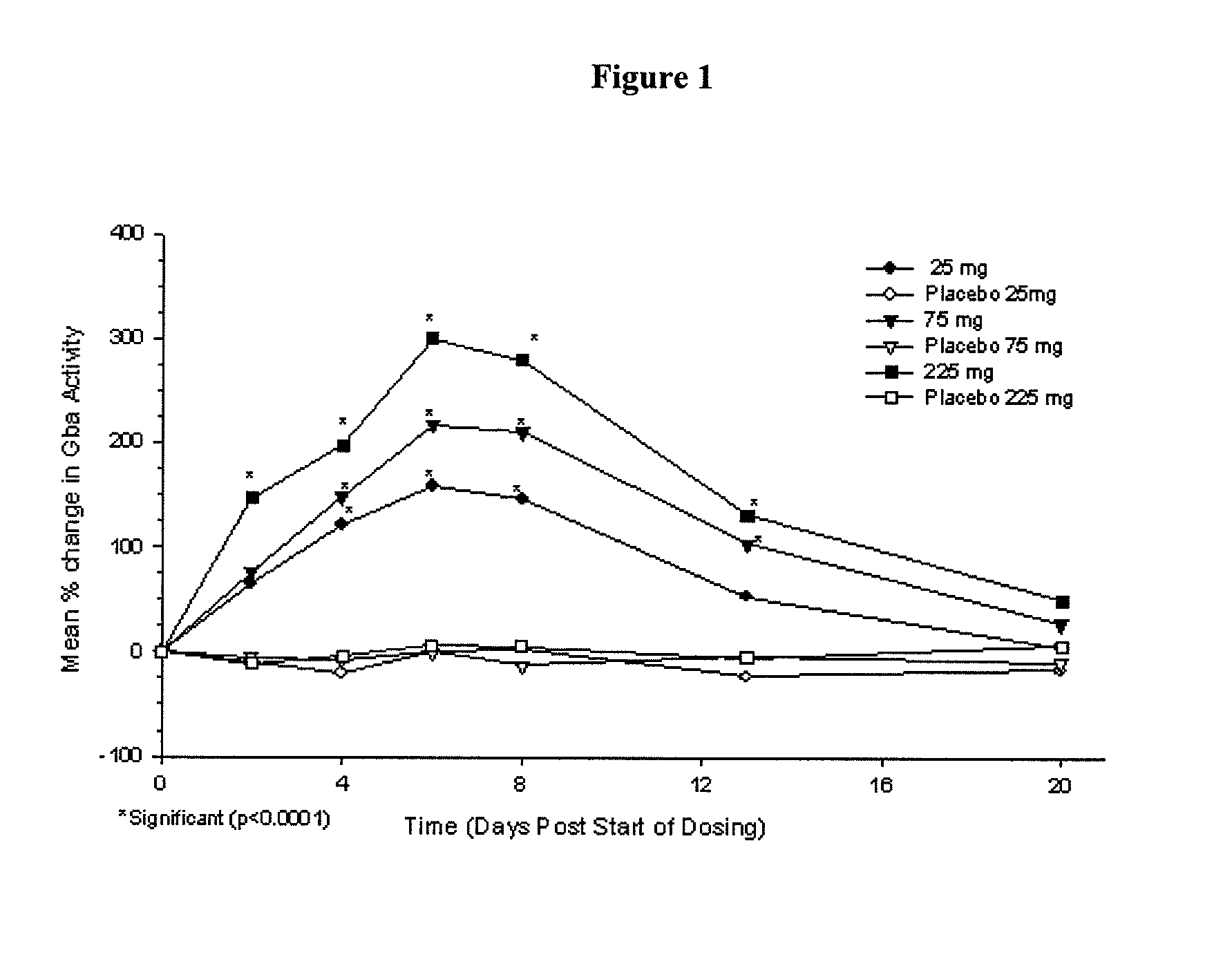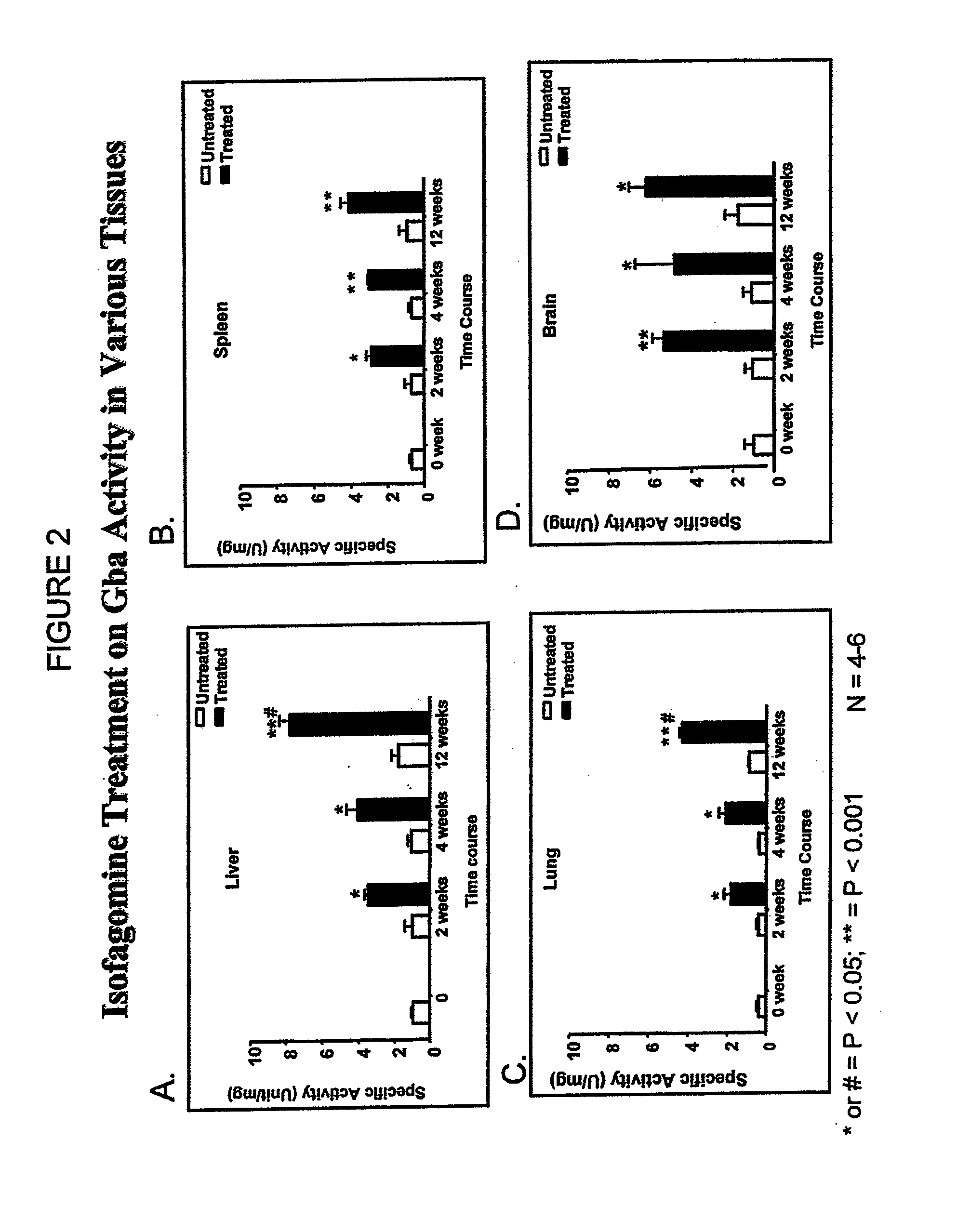Treatment of gaucher disease with specific pharmacological chaperones and monitoring treatment using surrogate markers
- Summary
- Abstract
- Description
- Claims
- Application Information
AI Technical Summary
Benefits of technology
Problems solved by technology
Method used
Image
Examples
example 1
Phase I Studies of the Safety, Pharmacokinetics and Pharmacodynamics of IFG Tartrate for the Treatment of Gaucher Disease
[0114]Using cell-based and animal models it has been shown that isofagomine increases cellular levels of glucocerebrosidase (GCase), the enzyme deficient in Gaucher disease. Randomized double-blind Phase I clinical studies were performed in 72 healthy volunteers, (39 male, 33 female). Isofagomine tartrate was orally administered as an aqueous solution. In a first-in-human single ascending dose study, doses of 8, 25, 75, 150 (two cohorts), and 300 mg were administered (6 active, 2 placebo in each cohort). In a multiple ascending dose study, doses of 25, 75, and 225 mg were administered daily for seven days (6 active, 2 placebo in each cohort). In both studies, isofagomine tartrate was generally well tolerated at all doses and treatment-emergent adverse events in both studies were mostly mild. No serious adverse events occurred.
[0115]Isofagomine tartrate showed good...
example 2
Determination of Surrogate Markers of Gaucher Disease in L444P Transgenic Mice Treated with Specific Pharmacological Chaperones
[0117]L444P transgenic mice (homozygous for human L444P mutated Gba on a glucosylceramide synthase null background) exhibit multi-system inflammation; B cell hyperproliferation; deficiency in GCase activity in the brain, liver, spleen, and lung; increased liver and spleen weights; elevated plasma levels of chitotriosidase at 3 months; and elevated plasma levels of IgG (Mizukami et al., J. Clin. Inves. 2002; 109: 1215-21). However, due to the disruption in the glucosylceramide synthase gene, these mice do not exhibit accumulation of GluCer in e.g., macrophages. Concomitant glucosylceramide synthase disruption is necessary since previously made L444P transgenic mice died within 3 days of birth due to impaired permeability barrier function in the epidermis.
[0118]In this experiment, the L444P transgenic mice were treated with isofagomine or C-benzyl-isofagomine ...
example 3
IFG Increases Levels of Glucocerebrosidase, Inflammatory Cytokines, and Bone Metabolism in Gaucher Patient-Derived Cells
[0139]To evaluate the effects of IFG on mutant GCase levels, an ex vivo response study with macrophages and EBV-transformed lymphoblasts derived from peripheral leukocytes of 60 patients was conducted. Plasma was also screened for potential biomarkers associated with inflammation, bone metabolism, and multiple myeloma. The study was conducted at eight sites in the United States.
Results
[0140]The study included 21 males with type I Gaucher disease, 1 male with type III Gaucher disease, and 18 females with type I Gaucher disease. Patients ranged in age from 7 to 83 years, and 38 of 40 patients were on enzyme replacement therapy (ERT). Macrophages were successfully derived from 34 of 40 patients, of which 32 demonstrated a dose-dependent increase in GCase levels (average=2.8-fold) when treated with IFG tartrate (5 days). Similar results were observed for 5 additional p...
PUM
 Login to View More
Login to View More Abstract
Description
Claims
Application Information
 Login to View More
Login to View More - R&D
- Intellectual Property
- Life Sciences
- Materials
- Tech Scout
- Unparalleled Data Quality
- Higher Quality Content
- 60% Fewer Hallucinations
Browse by: Latest US Patents, China's latest patents, Technical Efficacy Thesaurus, Application Domain, Technology Topic, Popular Technical Reports.
© 2025 PatSnap. All rights reserved.Legal|Privacy policy|Modern Slavery Act Transparency Statement|Sitemap|About US| Contact US: help@patsnap.com



